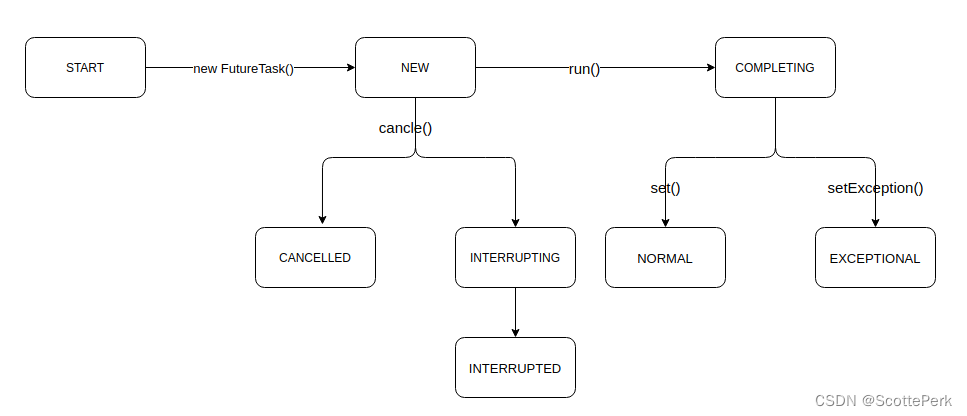官方文档解释:
Future表示一个异步计算的结果。并提供一些方法检测计算是否完成,等待完成,并取回数据。只有计算完成的时候,结果可以通过get方法获取。如果没有完成,则调用get方法的时候会阻塞。
官方文档是这么写的,翻译起来有点奇怪。
直接看源码更好理解,Future是一个接口,总共就5个方法。详细解释看注释。
原理介绍和基本使用
//Future本身的意思就是未来,表示任务的执行结果。虽然在定义的时候没有结果,但是到了任务执行结束就有结果了。
public interface Future<V> {
//取消任务
boolean cancel(boolean mayInterruptIfRunning);
//判断是否取消了
boolean isCancelled();
//判断是否完成
boolean isDone();
//获取任务的执行结果,如果任务没有完成,则会阻塞,知道任务完成,然后获取结果
V get() throws InterruptedException, ExecutionException;
//和上面的一样,如果超出给定时间,则会抛出异常
V get(long timeout, TimeUnit unit)
throws InterruptedException, ExecutionException, TimeoutException;
}
Future只是一个接口,他的一个最主要实现类是FutureTask。
public class FutureTask<V> implements RunnableFuture<V>
FutureTask实现了RunnableFuture,那么RunnableFuture接口又是什么呢?
RunnableFuture实际上就是结合了Runnable和Future接口。
public interface RunnableFuture<V> extends Runnable, Future<V> {
/**
* Sets this Future to the result of its computation
* unless it has been cancelled.
*/
void run();
}
下面举一个简单的例子来说明FutureTask的使用。FutureTask需要配合Thread使用,因为FutureTask本身是一个Runnable。FutureTask的get方法会等待结果完成,然后获取返回值。
public class FutureTest {
public static void main(String[] args) {
FutureTask<Integer> futureTask=new FutureTask<>(new Callable<Integer>() {
@Override
public Integer call() throws Exception {
System.out.println("start task");
Thread.sleep(3000);
return 123;
}
});
//FutureTask本身是一个Runnable和Thread可以完美配合
new Thread(futureTask).start();
System.out.println("do something in main thread");
try {
//等待执行结果并返回执行结果
Integer integer = futureTask.get();
System.out.println("result is "+integer);
} catch (InterruptedException e) {
throw new RuntimeException(e);
} catch (ExecutionException e) {
throw new RuntimeException(e);
}
}
}
输出:
do something in main thread
start task
result is 123
既然都使用JUC的高级类了,使用Thread类就有点low。可以配合Executors来使用。运行效果是一样的。
public class FutureTest {
public static void main(String[] args) {
Future<Integer> future = Executors.newCachedThreadPool().submit(new Callable<Integer>() {
@Override
public Integer call() throws Exception {
System.out.println("start task");
Thread.sleep(3000);
return 123;
}
});
System.out.println("do something in main thread");
try {
//等待执行结果并返回执行结果
Integer integer = future.get();
System.out.println("result is "+integer);
} catch (InterruptedException e) {
throw new RuntimeException(e);
} catch (ExecutionException e) {
throw new RuntimeException(e);
}
}
}
FutureTask的使用还是非常简单的,接下来要进行FutureTask的源码分析。
源码分析
FutureTask状态
最开始的几行是FutureTask的状态。
//初始化任务
private static final int NEW = 0;
//任务已经完成,分为正常完成和异常完成,是一个中间状态
private static final int COMPLETING = 1;
//正常完成,是最终状态
private static final int NORMAL = 2;
//任务已经完成,但是异常完成,是最终状态
private static final int EXCEPTIONAL = 3;
//任务还没开始执行就被取消了,是最终状态
private static final int CANCELLED = 4;
//任务还没开始执行就被打断(这里的中断指的是Thread的interrupt方法),是中间状态
private static final int INTERRUPTING = 5;
//任务还没开始执行就被打断(比如操作系统kill信号),是最终状态
private static final int INTERRUPTED = 6;
接下来介绍几个非常重要的成员函数:
//任务本身
private Callable<V> callable;
//任务结果
private Object outcome;
//运行的线程
private volatile Thread runner;
//等待节点,是一个Treiber stack结构
private volatile WaitNode waiters;
需要解释的就是WaitNode节点,是一个Treiber stack结构,Treiber stack是一种算法,Treiber Stack是 R. Kent Treiber在1986年的论文Systems Programming: Coping with Parallelism中首次出现。它是一种无锁并发栈,其无锁的特性是基于CAS原子操作实现的。总之就是能实现无锁并发,WaitNode本身是一个Linked List结构。
static final class WaitNode {
volatile Thread thread;
volatile WaitNode next;
WaitNode() { thread = Thread.currentThread(); }
}
运行结构图
整个运行流程如下图所示。其中这些方法和常量都可以在源码中找到对应的代码。

构造函数
就两个构造函数,一个传Callable,一个传Runnable。但Runnable最终还是转化为Callable。
public FutureTask(Callable<V> callable) {
if (callable == null)
throw new NullPointerException();
this.callable = callable;
this.state = NEW; // ensure visibility of callable
}
public FutureTask(Runnable runnable, V result) {
this.callable = Executors.callable(runnable, result);
this.state = NEW; // ensure visibility of callable
}
Executors.callable方法返回一个RunnableAdapter,这个适配器实际上就是将Runnable转化为Callable。
public static <T> Callable<T> callable(Runnable task, T result) {
if (task == null)
throw new NullPointerException();
return new RunnableAdapter<T>(task, result);
}
private static final class RunnableAdapter<T> implements Callable<T> {
private final Runnable task;
private final T result;
RunnableAdapter(Runnable task, T result) {
this.task = task;
this.result = result;
}
public T call() {
task.run();
return result;
}
public String toString() {
return super.toString() + "[Wrapped task = " + task + "]";
}
}

























 3083
3083











 被折叠的 条评论
为什么被折叠?
被折叠的 条评论
为什么被折叠?








